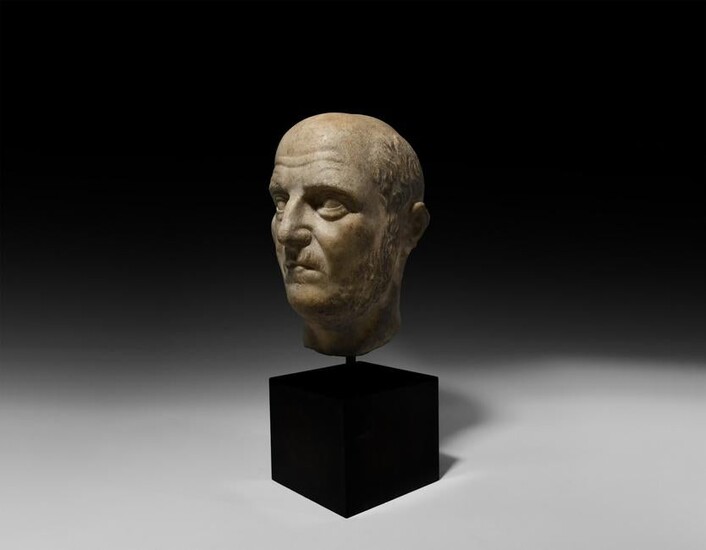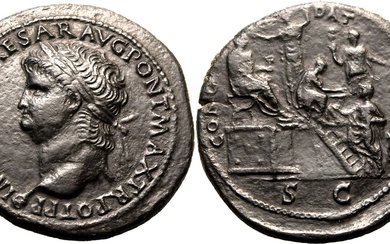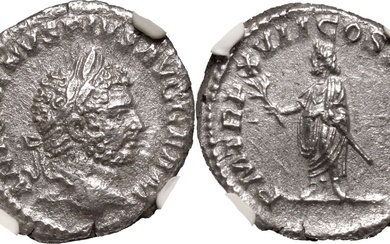Roman Head of an Emperor or a Military Leader
3rd century AD. A carved marble bust of a wealthy man with powerful expression, possibly a portrait of the Emperor Carus, close-cropped receding hair to the sides and rear of the head, furrowed brow above deep-set eyes, small fleshy mouth, short beard and moustache; mounted on a custom-made stand. See Bianchi Bandinelli, R., Roma, la fine dell'arte antica, Milano, 1970. Milner, C., 'Trades of the Lost Arts', Financial Times, How To Spend It, 24 April 2015, pp.10-11. 14.5 kg total, 44cm including stand (17 1/4"). From a private New York collection; formerly in a private UK collection, acquired before 1977; accompanied by an archaeological report by Dr. Raffaele DÂ’Amato; a copy of the Financial Times 'Trades of the Lost Arts' article and a scholarly note TL5304 by Dr Ronald Bonewitz; this lot has been checked against the Interpol Database of stolen works of art and is accompanied by AIAD certificate number no.163226-10062. The portrait, for the style and artistic structure, can be compared to the ones of Maximinus Thrax (Musei Capitolini, inv. MC 473, Albani collection), Philip the Arab (Bianchi Bandinelli, 1970, p.25 fig.20, Musei Vaticani, Braccio Nuovo), Trebonianus Gallus (Bianchi Bandinelli, 1970, p. 26, fig.21, New York, the Metropolitan Museum of Art) and to most of the emperors of the third century, like that of Trajan Decius (Musei Capitolini, inv. no. 121"). These portraits show merciless energy and indomitable vitality, in a way that Roman portrait sculpture had never shown before. Like in the portrait of Decius, this man is portrayed with bags under his eyes and a harsh facial expression, showing the anxiety felt by this ruler. The wrinkles on his forehead and around his mouth portray him as an intimidating leader, engaged in difficult times. Based on these traits, it can be proposed that this head could represent the Emperor Carus of whom we have only few portraits surviving: a marble portrait at the Ostia Museum (Inv. 75), other marble heads in Rome, Antioch and the Ny Carlsberg Glyptotek in Copenhagen, which have been proposed as possible portraits of Carus, though none are well accepted. [A video of this lot is available on TimeLine Auctions website]
Condition Report: Fine condition.
Estimate
Time, Location
Auction House
3rd century AD. A carved marble bust of a wealthy man with powerful expression, possibly a portrait of the Emperor Carus, close-cropped receding hair to the sides and rear of the head, furrowed brow above deep-set eyes, small fleshy mouth, short beard and moustache; mounted on a custom-made stand. See Bianchi Bandinelli, R., Roma, la fine dell'arte antica, Milano, 1970. Milner, C., 'Trades of the Lost Arts', Financial Times, How To Spend It, 24 April 2015, pp.10-11. 14.5 kg total, 44cm including stand (17 1/4"). From a private New York collection; formerly in a private UK collection, acquired before 1977; accompanied by an archaeological report by Dr. Raffaele DÂ’Amato; a copy of the Financial Times 'Trades of the Lost Arts' article and a scholarly note TL5304 by Dr Ronald Bonewitz; this lot has been checked against the Interpol Database of stolen works of art and is accompanied by AIAD certificate number no.163226-10062. The portrait, for the style and artistic structure, can be compared to the ones of Maximinus Thrax (Musei Capitolini, inv. MC 473, Albani collection), Philip the Arab (Bianchi Bandinelli, 1970, p.25 fig.20, Musei Vaticani, Braccio Nuovo), Trebonianus Gallus (Bianchi Bandinelli, 1970, p. 26, fig.21, New York, the Metropolitan Museum of Art) and to most of the emperors of the third century, like that of Trajan Decius (Musei Capitolini, inv. no. 121"). These portraits show merciless energy and indomitable vitality, in a way that Roman portrait sculpture had never shown before. Like in the portrait of Decius, this man is portrayed with bags under his eyes and a harsh facial expression, showing the anxiety felt by this ruler. The wrinkles on his forehead and around his mouth portray him as an intimidating leader, engaged in difficult times. Based on these traits, it can be proposed that this head could represent the Emperor Carus of whom we have only few portraits surviving: a marble portrait at the Ostia Museum (Inv. 75), other marble heads in Rome, Antioch and the Ny Carlsberg Glyptotek in Copenhagen, which have been proposed as possible portraits of Carus, though none are well accepted. [A video of this lot is available on TimeLine Auctions website]
Condition Report: Fine condition.







